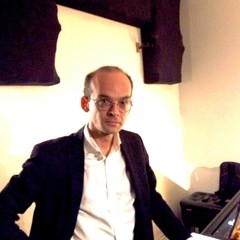|
Back
Czechs and Balances New York
Spectrum, 121 Ludlow Street
03/12/2016 -
Ondrej Stochl: Tri echa pred úplnkem
Leos Janácek: Po zarostlém chodnícku (1st Series): 2. “Lístek odvanutý”, 4. “Frýdecká Panna Maria”, 5. “Stěbetaly jak lastovicky” & 10. “Sýcek neodletěl!”
Michael Vincent Waller: Visages: II. “Year of the Ram”, III. “Maidens Dancing in the Nude”, IV. “Lashing Out” & VII. “Inside World” – Dreaming Cadenza
Johannes Brahms: Variations and Fugue on a Theme by Handel, Op. 24
David Kalhous (Pianist) 
D. Kalhous (© Samuel A. Dog)
The last time I heard David Kalhous, he was half of an excellent piano duo at BargeMusic, playing Kurtág and Brahms with terrific aplomb. Last night, at the always innovative Spectrum, Mr. Kalhous played 50 percent music of his own birthplace, with equal aplomb.
No matter which century Czech music comes from, one knows almost instinctively it will offer surprises, musical, literary or just plain with kinky abandon. Like Czech films, the emotion under the surface gives a circumspect wink to the music on the clefs. That was true with Martinů, with Suk, and especially with Leos Janácek, four of whose On An Overgrown Path were performed here.
One always has the feeling with Janácek that, except for the country and generation, he and Thelonious Monk were musical clones. That they both could have created pretty little tunes, but chose to extend the scale for more mysterious feelings. That both Janácek and Monk could use form and structure when necessary, but preferred the illusion of improvising their melodies into a land of personal dreams, never quite visible to the listener.
That was certainly true of the four sections from On An Overgrown Path. The pianist chose them from the first series, music which disguises itself as simple, almost Schumannesque. The secret–and perhaps only Czech pianists like Firkusný could master it–is pretending improvisation (like Monk’s late-night ramblings) but actually holding it together.
Mr. Kalhous came near to this with an impressionistic “blown-away leaf” and the visit to “The Madonna of Frýdek”. The final works have titles incluing birds. But Janáček was not Messiaen, and he never attempted to imitate either “Swallows Chattering” or a barn owl.
That final selection has the only musical title I can think of which depicts something which isn’t happening. I.e.: “The Barn Owl Has Not Flown Away”. On the other hand, the choral melody played by Mr. Kalhous–the only clear melody of these four impressions–might well be a Czech folk song about barn owls. The entire series was played with an impromptu, slightly melancholic delight.
Mr. Kalhous, though, started with a work dedicated to him from a fellow student in Prague, Ondrej Stochl’s Three Echoes Before a Full Moon. The title sounds almost Chinese, but the trio of pieces was more reminiscent of Wallace Stevens’ Thirteen Ways of Looking at a Blackbird. The music was oblique, quirky, and made good use of Mr. Kalhous at both ends of the keyboard.
Was it my imagination? Or was Mr. Stochl using the bass as the earth, and the high treble as the full moon? And were Mr. Kalhous’s intricate note duplications like sonar waves between our two celestial bodies?
Perhaps not. But the three short pieces were intriguing, complex and, with my questionable imagination, very imagic as well.

M. V. Waller (© Samuel A. Dog)
The composer Michael Vincent Waller was present for five Visages out of many he has written. His inspirations are, yes, faces, and his music is unpretentious, restrained, melodic. His Year of the Ram had no ovine significance. Instead, the pentatonic themes in the treble, floating above a bass ostinato (the latter a constant in all the music, almost like the preceding Janácek) was obviously Chinese.
Next came the premiere of Maidens Dancing In the Nude. Nothing was enigmatic about this. It was a variation of an Erik Satie Gymnopédie, itself a neologism but referring to a an ancient Greek dance. (Mr. Waller’s gender of the dancers was added to Satie’s indeterminate performers.)
The following Visages, Lashing Out and Inside World were not so impressive, but the Dreaming Cadenza, written for Mr. Kalhous’ performance, was dreamily improvisatory.
The second half was devoted to Brahms’ masterly Handel Variations, and for this, Mr. Kalhous had two deficiencies, neither his own fault. First, the same piece was played last week by Ian Barnatan, who is a born Brahms player. That performance was intense, largely conceived, and truly memorable.
Second, Spectrum, one of my favorite small concert halls, is more of a salon and these Variations were for the large concert hall. The Steinway Grand here had a percussive rather than elevated sound, the instrument sounding somehow awkward.
Still, Mr. Kalhous, a student of Paul Badura-Skoda, Peter Frankl and other German-oriented teachers, did a good job. Where Mr. Barnatan had made this a cohesive whole, Mr. Kalhous started with a very light touch, advanced to more sonorous studies, and finally gave a splendid fugal finale, splendid enough that the Chopin mazurka encore only detracted from his achievement in this great work.
Harry Rolnick
|